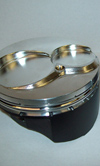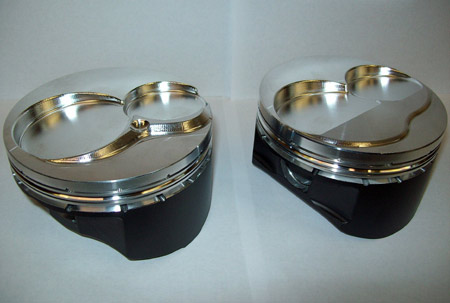Midget pistons part of a longevity boost
 Stanton Racing Engines in Nicholasville, Kentucky, is known for its USAC Midget and Sprint engines. While once predominantly a Mopar/Dodge house, three years ago the company began to build/rebuild Toyota USAC Midget engines, taking over the work from California-based Toyota Racing Development (TRD).
Stanton Racing Engines in Nicholasville, Kentucky, is known for its USAC Midget and Sprint engines. While once predominantly a Mopar/Dodge house, three years ago the company began to build/rebuild Toyota USAC Midget engines, taking over the work from California-based Toyota Racing Development (TRD).
Erik Milholland manages Stanton's racing division, and travels with the USAC circuit, handling any powertrain issues its customers might have.
The Toyota and Mopar engines have differing cylinder heads that necessitate a choice of dome shapes on its forged pistons. "With our current cylinder head-camshaft combination," Milholland says, "the lower piston dome of .020 on both our Toyota and Mopar engines performs better because of less disruption of airflow."
The 2618 forged aluminium piston has three rings - the gapless top and second rings are 0.032-and-a-half while the oil ring is 2 mm. The Toyota piston weighs 465 g; the Mopar is 450 g.
"We use a shorter dome because we wanted to flow more air through the combustion chamber. That's our basic priority," Milholland says. "We can do that with smaller combustion chambers on our cylinder heads and still keep our compression up where we want it to be, even as we minimise the dome shape."
The compression on these national USAC Midget engines is 15:1, and the Toyota and Mopar inline four-cylinder engines make upwards of 390 hp on the dyno and about 365-370 hp at the wheel, which is standard for the breed.
With their emphasis on low-end torque for racers competing on differing track sizes and specifications - both asphalt and dirt - engine builders in the USAC National Midget Series also have to deal with a limit of 8700 rpm for pushrod engines like those produced by Stanton.

The shorter piston dome shape came about because Stanton had cracking and breakage problems with its previous manufacturer's design. "Our new partner helped us work on our own piston and ring package designs so that we've been able to eliminate those problems," Milholland says.
In the Toyota and Mopar engines that Stanton produces, he says, "The shapes are different because the cylinder head shapes are a bit different. Still, overall, the pistons - as far as the forgings, coatings and ring packages go - are all primarily the same."
Skirt profile is determined by "trial and error on our end," Milholland confesses. "We've run piston clearances as low as three or four thousandths and as big as eight or eight-and-a-half thousandths. Over the last year-and-a-half or two years, analysing skirt profile, we came up with the height clearance and skirt profile we were looking to achieve."
To accomplish piston cooling, he says, "We run a twin oiler system squirting two jet oilers on the piston and pin at all times with the Toyota, whereas we only run a single oiler on each cylinder with the Mopar. The Toyota is a purpose-built engine specific to the Midget racers, and they did a really good job of building up the oiling system. We have a little machine process we go to with the Mopar engines, so we can go to the main oil gallery and feed that single oiler to the piston."
Wrist pins, which come with pistons from the manufacturer, are Casidiam coated and according to the engine being prepped. "The Toyota was developed with 0.866 pins, and the rods are fitted for that dimension," Milholland says. "The Mopar engines run the standard 0.927-diameter pins everyone else uses." Pin retention is by round wireclip.
Stanton Racing likes to check the pistons after four to six nights of racing and may, depending on the client's budget, re-use them. "We make sure the clearances, pin bores and rings are all within tolerances. We recommend ten to 14 nights on an engine, but that depends on the size and length of the track ,and the type of circuit. We have more wear with dirt, but dirt always gets into these engines," Milholland says.
He reckons 90% of the engines get new pistons each time they're rebuilt. "If they're coming back for a rebuild, you might as well spend another $1000 and get new pistons. A standard rebuild runs to $5000-7000; fresh engines cost around $33,000," he says.
Because the USAC National Midget Series isn't in the best of health - and because this is, after all, a business - Stanton Racing has gone to a heavier piston for its inline fours. "We've been helped out by the rpm rule, and lighter is not always better. We're still able to pull the rpm with our heavier piston, and we've got our longevity. By adding a bit of weight we're able to get our engines to live longer, and we've doubled or even tripled the life expectancy of our engines," Milholland says.
"With the added piston weight, your biggest thing is taking the bob weight, the rotating assembly balance and crankshaft balance into consideration. We're probably giving up 15-20 g - a total of maybe 80 g overall - but we're getting much more life out of it. You've got to keep the cars going and keep the customer happy."
At the Turkey Night Midget Grand Prix on the half-mile Toyota Speedway at Irwindale on Thanksgiving night, Stanton Racing's engines set fast times, a new lap record and won the race. That's keeping the customer happy.
Fig. 1 - Toyota (left) and Mopar pistons have coatings on all but the short dome and in the ring grooves (Photo: Erik Milholland)
Written by Anne Proffit